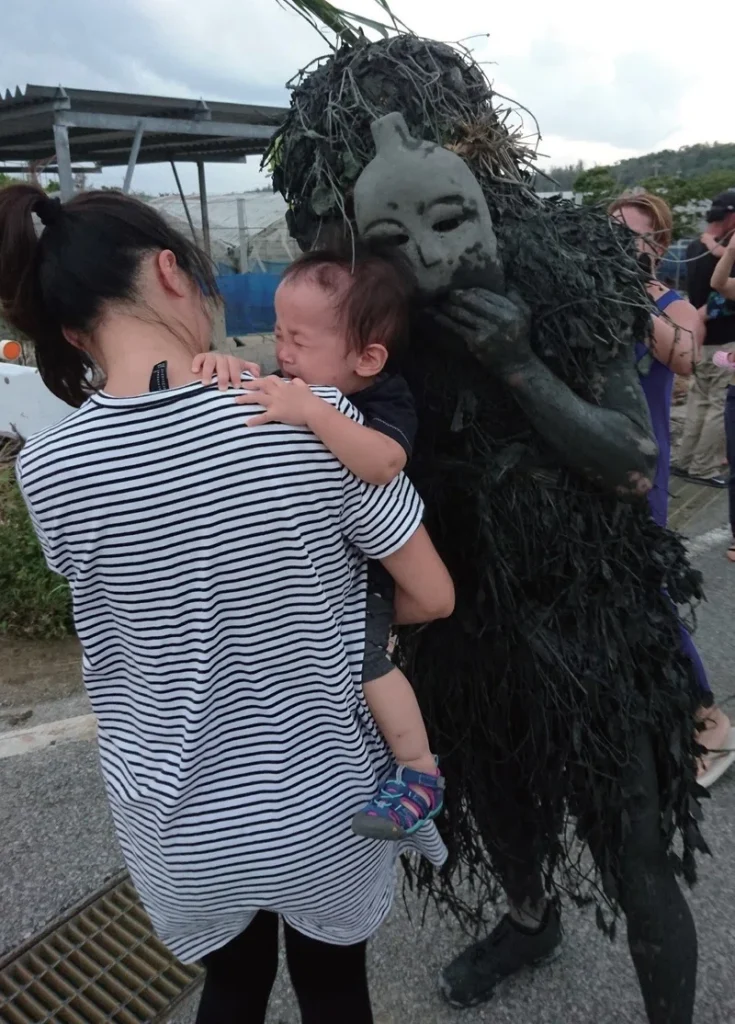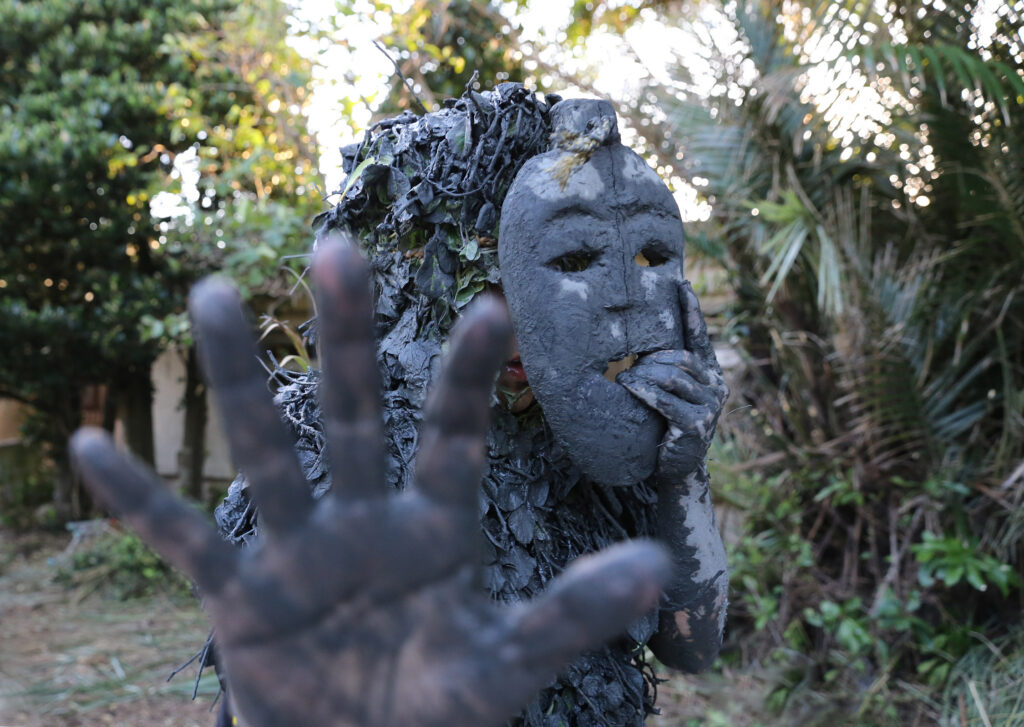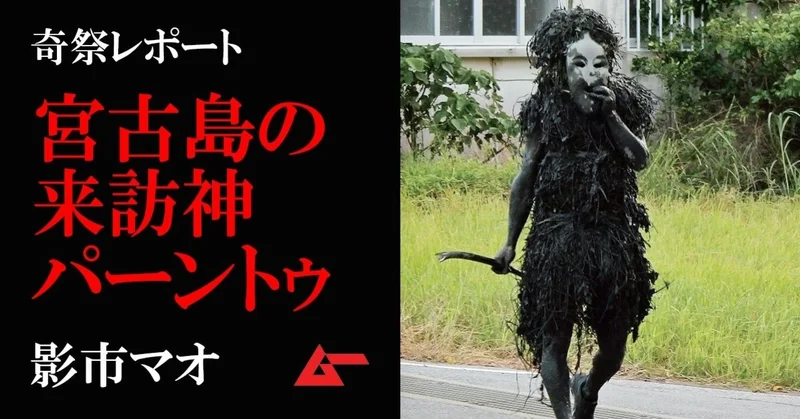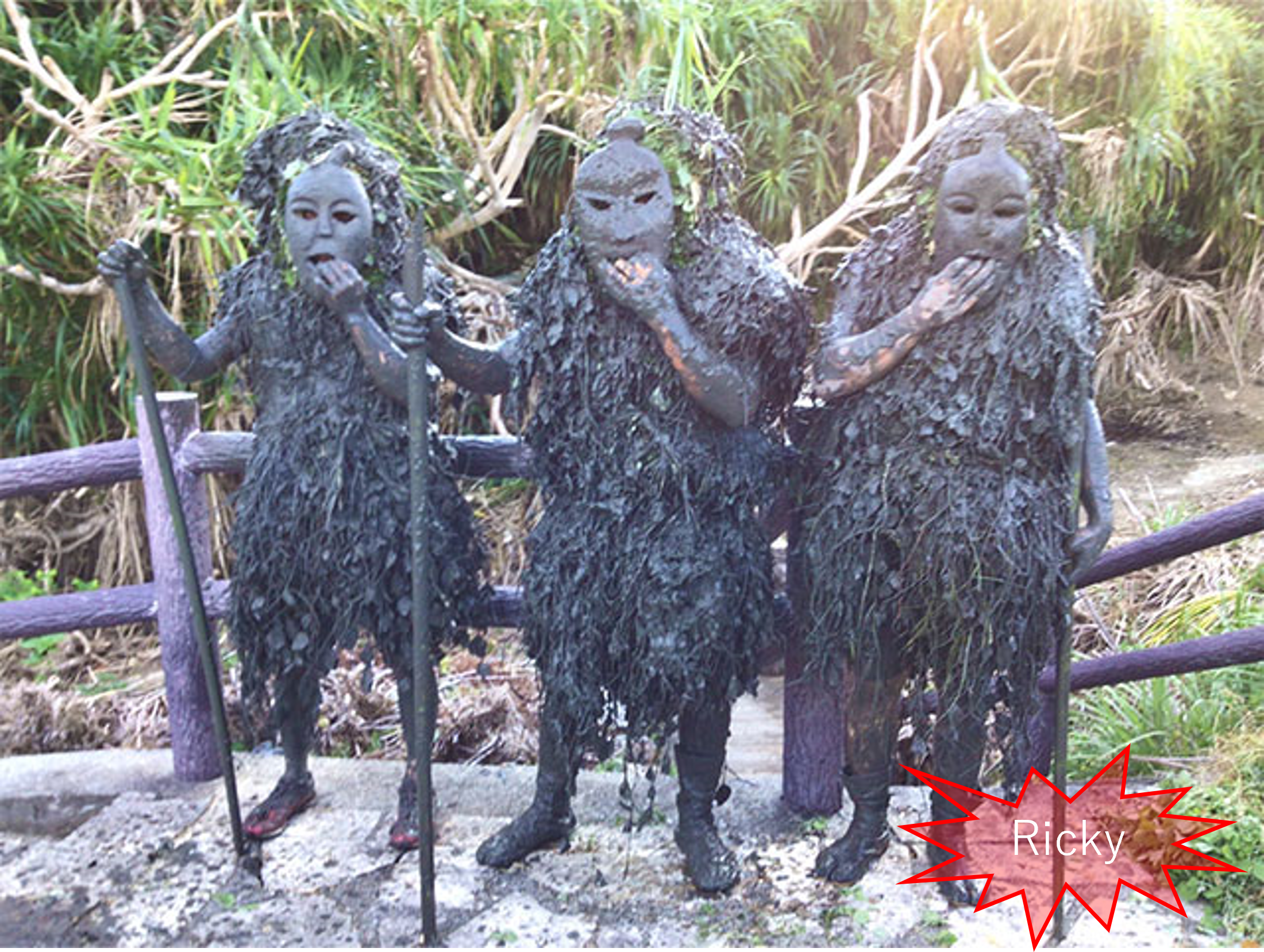On a previous visit to Miyako Island, I went to the Miyakojima City Museum to learn about the history of the island. There were exhibits that introduced the flora and fauna of Miyako Island, as well as various traditions handed down from generation to generation. Among them, there was one in particular that grabbed my attention.

Two life-size dolls stand tall in the museum. They have black masks and their fronts are covered with what looks like plant leaves. They stood out blatantly different and conspicuous among the surrounding exhibits. According to the information board, it was a deity in a traditional Miyako Island event called “Pāntu,” which has been handed down from generation to generation. I was strongly attracted by its appearance, which reminded me of the atmosphere of tropical countries and which is not often seen in the archipelago, and this led me to write this blog.
What is Pahntau?
Pāntu is a traditional event held on Miyakojima Island in Miyakojima City, Okinawa Prefecture, to drive away evil spirits. Pāntu, a visiting god wearing a mask, goes around the village to drive away evil spirits. The event is held in two districts, Hirara Shimajiri and Uenohara, but the content differs between the two districts; in 1982, the events in both districts were selected as “Miyako’s Pāntu” as a Selected Intangible Folk Cultural Property, and in 1993, they were designated as “Miyakojima’s Pāntu” as an Important Intangible Folk Cultural Property. In addition, in 2016, it was proposed for registration as one of the “Visiting Gods: Gods of Masks and Masquerades” as an intangible cultural heritage by the United Nations Educational, Scientific and Cultural Organization (UNESCO), and although the examination was postponed, it was re-proposed in 2017, and the registration was decided on November 29, 2018. As for the etymology of the word, “Pāntu” means ghost or demon god. In “Miyakojima Folk History” (Inamura Kenshiki, 1948), a book written about the history of Miyako Island, it is theorized that the word is an accented form of “paan (to eat) + pitu (person)”. The origin of the word seems to date back more than several hundred years, when a mask wrapped in a kuba (loquat) leaf drifted ashore in the sea in the northern part of the Shimajiri area. It is said to be based on a myth that a young man picked up the mask, applied mud to his body, and became a visiting deity.

Pahntu Satupunaha in Shimajiri, Taira District

In Shimajiri, Satupunaha (Satu-punaha) is held three times each year (from the end of March to the beginning of April of the lunar calendar, from the end of May to the beginning of June of the lunar calendar, and on the first day of September of the lunar calendar), and Pāntu appears on the third of these occasions. For this reason, the third Satupunaha is called Pāntu Satupunaha or Pāntu Punaha. The holding organization is the Shimajiri Community Association. The Pāntu here consists of three visiting deities, Uya Pāntu, Naka Pāntu, and Hufa Pāntu, and is performed by selected young men from the Shimajiri area. In the evening, the three Pāntu appear, masked and clad in a vine called “shinokikazura” (local name: kyān), with mud from the bottom of a well called “maligā” (a fertile spring) applied to their bodies. The “maligar” is located on the east side of Miyajima Elementary School (closed in 2017), and was once used as a birthing spring and as water to purify the dead. Pāntu is a ceremony in which people pray to five mizumai (goddesses) at a place of worship called Upattanushibara on Motojima (the birthplace of the village), and then go around the village to drive away evil spirits. After praying to the five mizumai (goddesses) at Upattanushivara, the villagers go around the village to drive away evil spirits. The mud collected from the “maligars” emits a strong odor, and the smell does not come off for several days after it is applied. In the past, it was often used to drag around troublesome people in the village, and it is said to have played a role in maintaining communal order. Pahntu often entered unlocked houses without permission (naturally, the inside of the house would be covered in mud), and it is a must to visit newly built houses and offices as a way of exorcising evil spirits. In addition, at “mutu,” a sanctuary on the island where the local deity of the village is enshrined, it is customary to serve sake to Pāntu when he intrudes, and only then does Pāntu temporarily quiet down by sipping the awamori that is served to him.
Pāntu in the field of Ueno District

The ceremony is held on the last Ox day of the twelfth lunar month. The organization holding the ceremony is the Nohara Tribal Association. Locally, it is also called Satiparou or Satiparai (Satobarai). Only adult women and boys participate, not adult men or girls. One of the boys, wearing a Pāntu mask, departs from a well called “Neemagar,” followed by the other boys and the women in two lines. Two of the boys blow conch shells and one plays a small drum. The women wear grass crowns made of kurotsugu (dialect name: mani) or senninso (dialect name: tadunai) on their heads and grass belts around their waists, and hold branches of yabunikkei (dialect name: tsuzagui), which is used to exorcise evil spirits, in both hands. The procession first worships in front of the large Utaki located in the east of the village, and then marches through the village chanting “hoi hoi” to drive away evil spirits. When the procession arrives at a place called Musulunmi, located at the southwestern edge of the village, they remove their grass crowns, grass belts, and twigs, and perform a winding dance to conclude the event. Similar festivals are said to exist in Indonesia and Micronesia.
Theories of origin from abroad
While chasing after fleeing people, Pahntu makes a pilgrimage to the “mutu” (houses where masks are usually kept), which are places of worship scattered throughout the village. The scene of their prayers is not open to the public, and the mystique unique to the taboo-laden southern islands seems to have been preserved. The word “taboo” is said to have originated in the Tongan language, and was popularized at the end of the 18th century when the British explorer Captain Cook introduced Polynesian customs. The masked rituals of Pāntu on Miyako Island and Bose on Kareishi Island also remind us of their southern origin. The Okinawan dialect is also said to have something in common with Indonesian, as the word for “mixing” is the same as “campur,” and the Indonesian word for ghosts and monsters, “Hantu,” also suggests a connection with Pāntu. Moreover, this Hantu is an inversion of the word “Tuhan,” which means god, and is quite interesting because it resembles the position of Pantu, which has a mixture of elements of gods and demons.

Festival Day
So what is the actual festival day like? The following excerpts are from a report by occult enthusiast Mao Kageichi.

On October 25 and 26, 2017, “Pāntu Punaha,” also known as “the most terrifying festival in Japan,” was held in the Shimajiri community of Miyakojima City, Okinawa Prefecture. In this shocking traditional event, three “Pāntu” visiting deities clad in black mud chase people around and mercilessly smear them with mud, no matter who they are. <The three Pāntu finally emerged from Maligā at a little past 5:00 p.m., as we waited for some time in the calm before the storm, with a fresh wind blowing in the wake of the approaching typhoon. They were composed of a parent and child masked deities named “Uya (parent),” “Naka (middle),” and “Fa (child),” respectively, and they came zipping toward us from the far side of the single road. The masked gods are there to ward off evil spirits, but their black, mud-covered forms are more like evil spirits themselves. The young men of the youth association are chosen every year to perform the ritual, but the power of the ritual is so strong that it is hard to believe that they are dressed up as such. As the spectators watched the gradually approaching gods with bated breath, a member of the film crew of a certain TV station, who was leaning forward the most, was first given a good beating with mud, just to show him what a good show he could make. The three parties then began to attack one another. The peaceful village became the scene of another tragedy this year. <Omission> <Omission> <Omission> <Omission

Around 6:00 p.m., people who had finished school or work joined the festivities, and the frenzy reached its peak. The idyllic atmosphere of the previous day is replaced by a muddy, mud-covered crowd in the area around the Shimajiri Purchase Store, creating a scene that resembles something out of a zombie movie. As the sun eventually sets, the true horror of the village begins to set in. Since there are few streetlights in the area, Pahntu blends in completely with the darkness and becomes a veritable hard mode of hauntings. People become suspicious and fearful of anything moving or noises nearby. I was mistaken several times for Pahntu when I was wandering around (pardon the pun). In the old days, when there were no lights and fewer onlookers than there are now, the fear of parantu must have been truly uncanny. At around 8:00 p.m., the three Pāntu, which had joined together on the outskirts of the village, disappeared into the darkness, and the sirens sounded like an alarm to announce the end of the event. Thus ended the strange game of tag that had unfolded in the southern tip of Japan for three hours.
At the end.
I had the misfortune of not being able to see Pāntu in person, but after reading Kageichi’s detailed report, I was suddenly inspired to see it with my own eyes. I am not comfortable with the idea of being covered in mud, but if it is to ward off bad luck, then so be it. It is more valuable to be able to feel the gods and the style of the festival, which are unique to the southern islands and not found in the archipelago. I would like to visit the festival at least once on the day of the festival before this rare traditional event fades away.
★The writer of this blog: Ricky★
Leave it to us when it comes to cultural matters! Ricky, the Japanese culture evangelist, will turn you into a Japan geek!

Source
Visit to Pāntu Punaha, a strange festival in Miyako Island! Encounter with the mud-covered visiting god / Strange festival tour, Kageichi Mao

Pāntu Wikipedia



